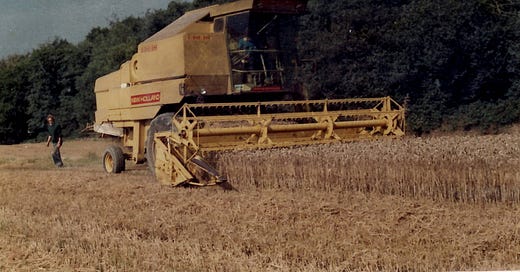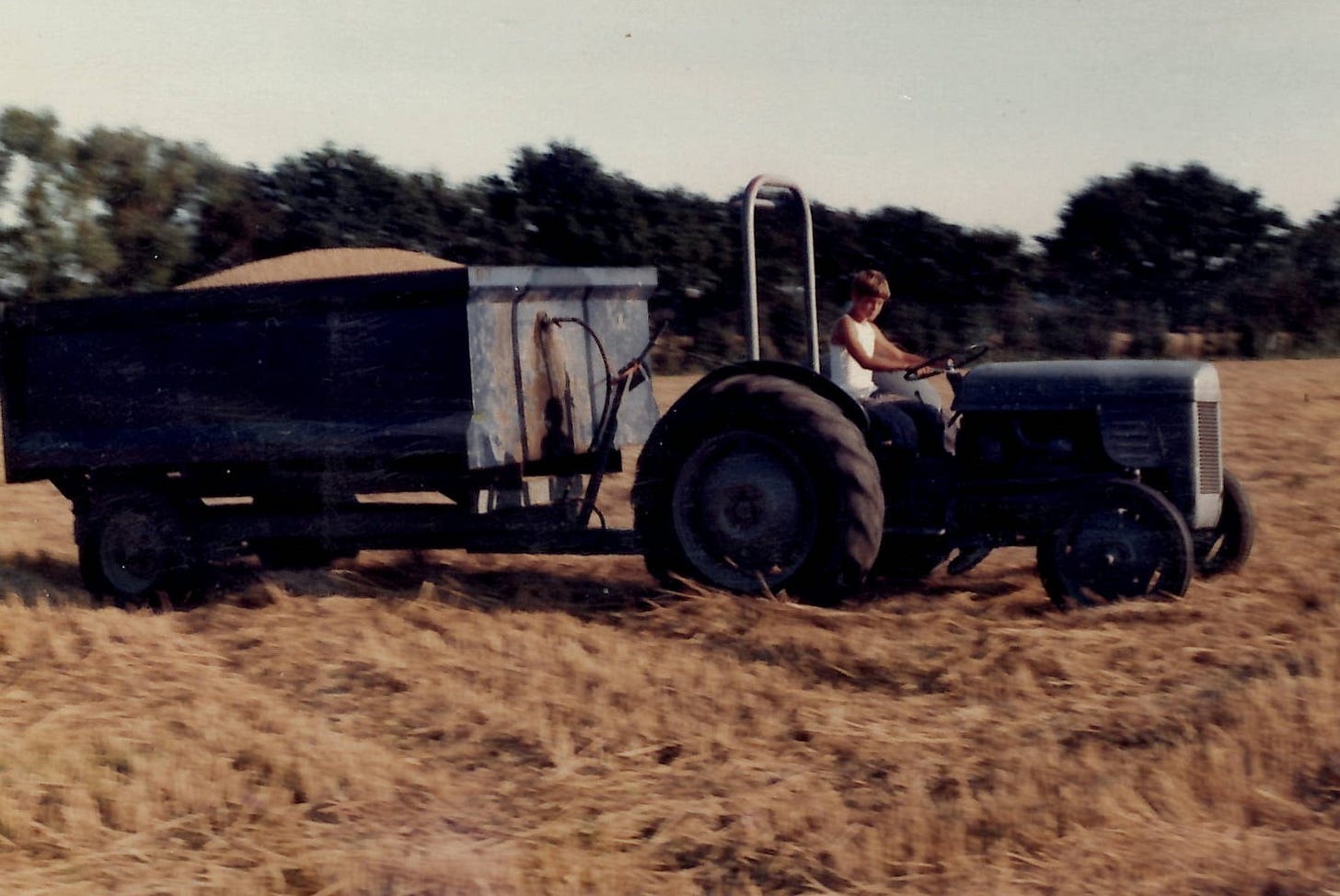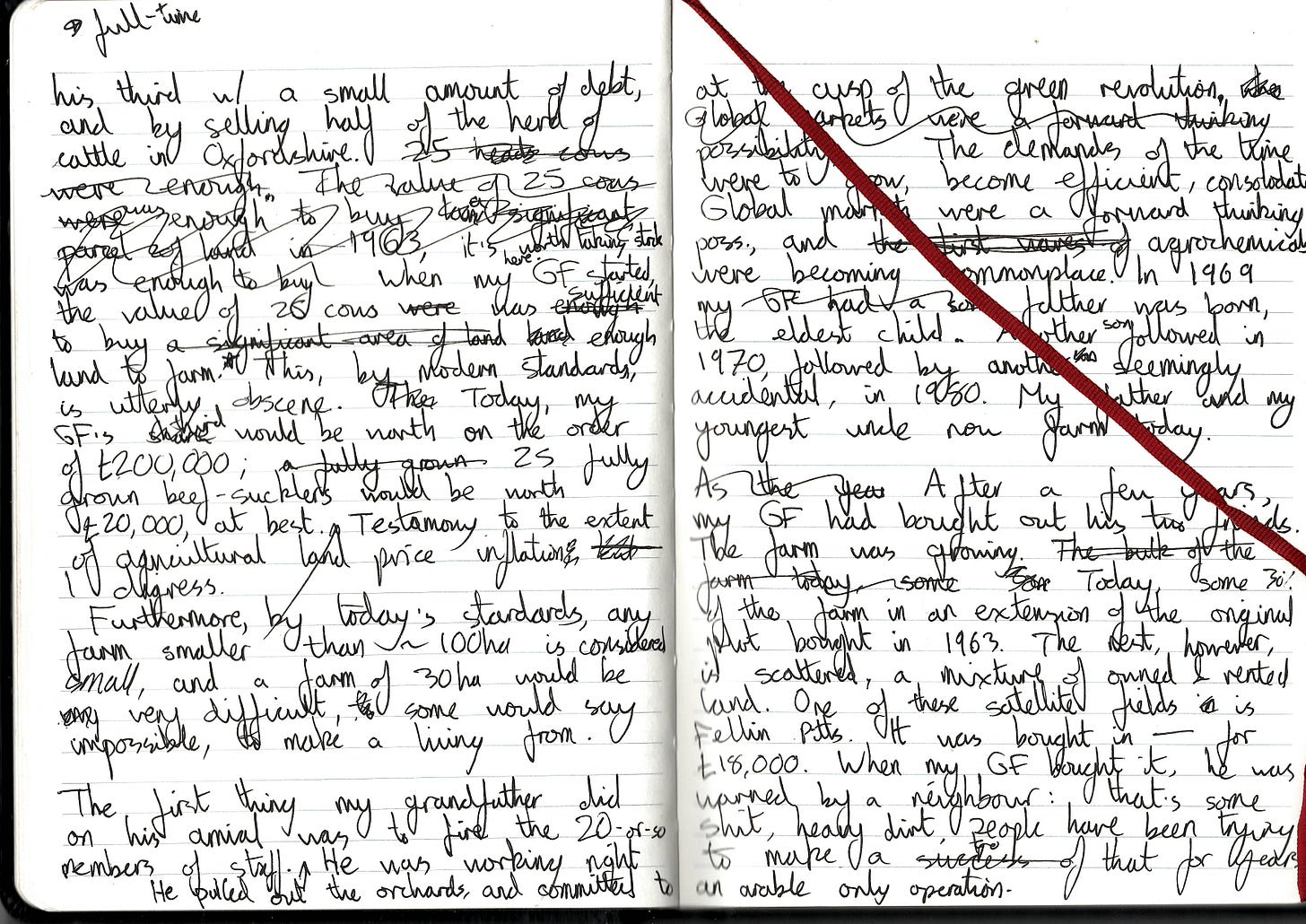My grandfather turned 94 this week. The following is largely a rewritten version of the conversation we shared.
My grandfather was born in Oxfordshire, in the summer of 1930, the eldest of three children. He spent his entire working life as a farmer. His father was a farmer, as was his father before him. Further than that, the trend is less clear. When asked, my grandfather only spoke as far back as his grandfather, born near the middle of the 19th century. I think it’s fair to assume that the trend continues for many generations, but I wouldn’t like to say for certain.
In Oxfordshire, my grandfather and great-grandfather lived and worked on rented land. I’m told that it was a beautiful valley near the Oxfordshire-Buckinghamshire border. I’m also told that it was poor, flinty land. It was a small mixed farm. According to family lore, there is a church near Grafton, Oxfordshire, whose graveyard is filled with the tombs of people who bore the Wise family name.
At aged 16, my grandfather left home, to find work elsewhere. He worked on multiple farms, before eventually becoming farm manager. There, he stayed for the guts of a decade. In the 1950s, he returned home to work with his father. I imagine that this was to help him as he aged, as the physicality of farm work became more demanding, but I am slightly filling in the gaps here. Eventually, their working relationship proved untenable, and so my grandfather decided to look for a more permanent home.
Initially, he decided to look west, towards Somerset and Devon. It was a chance encounter that led him to choose Kent. In a pub one evening, he was explaining his quest to a stranger. This man told my grandfather that he knew of someone selling land in Kent. The garden of England. It was currently in orchards, he said, but it would fit what my grandfather was looking for. Plus, it’s almost certain that in a few years, the entire place would be under a new housing estate.
This final point grabbed the attention of two friends of my grandfather. Nestled on the outside of a small, but growing, town of Paddock Wood this prediction of the man in the pub was a safe bet. In 1963, the three bought the land together. The arrangement was that my grandfather would farm, whilst the other two would remain in Oxford, as landlords. When my grandfather started, the farm was approximately 30 hectares. He funded his third with a small amount of debt, and by selling half of the herd of cattle in Oxfordshire.
It’s worth briefly taking a step back. When my grandfather started, the value of 25 head of cattle was sufficient to buy enough land to farm on a full-time basis. This, by modern standards, is utterly obscene. Today, my grandfather’s third would be worth approximately £250,000; 25 head of cattle would be worth £50,000, at best. Furthermore, by today’s standards, any arable farm of less than 100 hectares is generally considered small, and an arable farm of 30 hectares would be very difficult, some may say impossible, to make a living from. A small testimony to the changes of the scale in modern agriculture, but I digress.
On his arrival, the first thing my grandfather did was to let go the 20-some members of staff. Next, he pulled out the orchards. He committed to an arable only farm, forgoing the tradition of mixed farming. He was working right at the cusp of the green revolution. The demands of the time were to grow, to become more efficient, to specialise. Global markets were an immanent, forward-thinking possibility, and agrochemicals were becoming commonplace. In 1969, my father was born, the eldest child. Another son followed in 1970, followed by another in 1980. My father and youngest uncle now farm today.
After a few years, my grandfather bought out his two friends. The farm was growing. He did well. Today, some 30% of the farm is an immediate geographical extension of the original plot bought in 1963. The rest of the farm, however, is scattered about. It is a mixture of owned and rented land. One of these satellite fields, as they are known, is Fellin Pitts.
My grandfather bought Fellin Pitts in the 1970s for £18,000. It is nearly 40 hectares, or almost exactly 100 acres, in size. When he first arrived, there was an old house in the middle of the field, and a patchwork of hedges to subdivide the area into multiple smaller fields. Before buying, he was warned against the purchase by a neighbour: that’s some shit, heavy dirt, he said, people have been trying to make a go of that for years, but no-one’s had much luck. In another testament to the madness of agricultural economics of the time, it made better financial sense to tear down the house, and the patchwork of hedges, to farm the land as one continuous block, rather than deal with the hassle of working around the building.
Dad worked on the farm from a very young age. Like his father, he left home aged 16, and spent a few years working elsewhere, on other people’s farms. First in the UK, but then later in Australia, New Zealand, South Africa, and Ireland. He came back to farm in Kent permanently in 1995, aged 26, and I was born two years later in 1997. Nominally, my grandfather retired in the mid-2000s, but he is still firmly invested in the farm. To this day, he hasn’t really retired.
I broke tradition somewhat by choosing not to leave home aged 16. I stayed in school until 18, then went to university. Unlike my father and grandfather, my period of training off the farm was much briefer: a year spread across four farms in the UK. In September of this year, to much cynicism from my father, I will be taking on half of Fellin Pitts, aged 26, to run an organic arable unit. I arrive the least experienced, and the most full of ideas of how to do things differently. But, as they say, there’s nothing new under the sun.
Glossary
Green revolution — the changes in farming during the second half of the 20th century; it can be characterised by the introduction of agrochemicals, modernised machinery, and specialised production. In my eyes, it is the systematic application of the industrialised mindset to agriculture.
Mixed farming — an older system of farming, one that predates the specialisation brought by the green revolution, that has both livestock and arable components. There is great symbiosis between these two systems.






